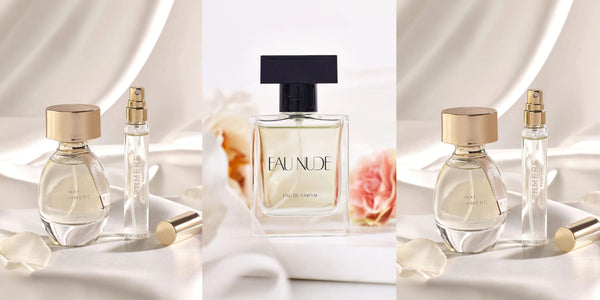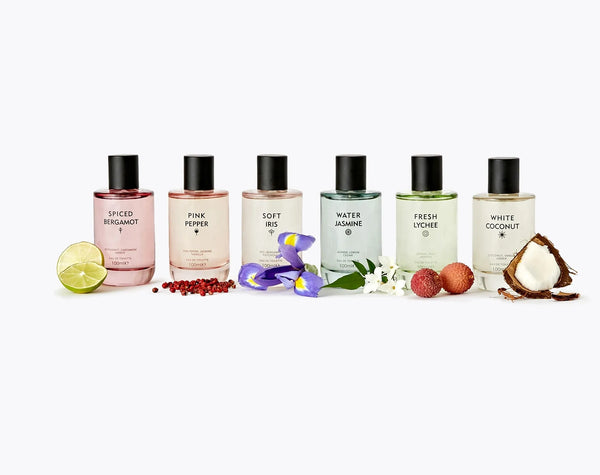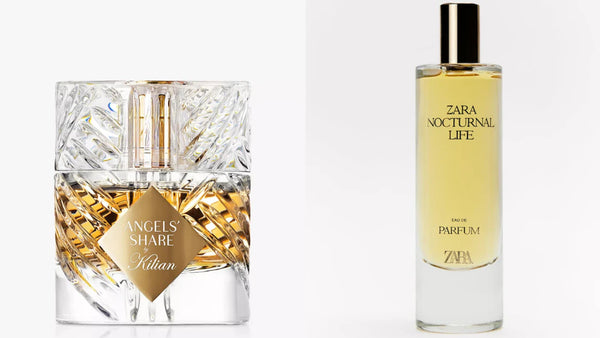What are Aldehydes and how are they used in perfume?

Perfumery is an art form that thrives on the creation of fragrance mixtures. The perfumer needs a nose for fragrance and a good understanding of the materials at his or her disposal and the desired end smell. Materials that can be blended to create perfumes include essential oils, absolutes, ionones, ketones, esters, solvents, and of course, aldehydes.
Aldehydes are organic compounds with a strong odor that are often used as raw materials in perfume creation. In this blog post, we will be talking about what aldehydes are and how they’re used in perfumery. We will also be touching upon the olfactory prowess of aldehydes and the perfumes created from them, as well as the most commonly used aldehydes in perfumery.
What Are Aldehydes?
Aldehydes are organic compounds containing a terminal carbonyl group, with the chemical formula -CH=O and a general formula of R-CH=O. They are used in the manufacture of synthetic resins and perfumes, as well as for the creation of dyestuffs, flavorings, and other chemicals.
Aldehydes can be divided into two main categories: aromatic aldehydes and aliphatic aldehydes. Aliphatic aldehydes are more commonly used in perfumery because they have a stable structure and a distinct smell. In contrast, aromatic aldehydes have a complex structure and cannot be easily identified by smell.
Aldehydes are essential to the perfumery industry as they provide fragrance notes with fruity, green, or floral scents. However, their use is not without controversy.
Some environmental advocates argue that aromatic aldehydes can be harmful to the environment as they are prone to biodegradation. Besides, their production requires the use of hydrocarbon ingredients that can be harmful to the environment.
The Olfactory Prowess of Aldehydes
Aldehydes are a group of chemical compounds with a distinctive odor. They are the main contributors to the fragrance of perfumes and essential oils. Aldehydes can be derived from substances such as sugar, fatty acids, and alcohols.
The odor of aldehydes varies from citrus to fruity to floral. In perfumery, aldehydes are used for their ability to create unique scents. This is because they can be blended with other fragrance ingredients to create unique perfumes.
As mentioned earlier, aldehydes are used for their ability to create unique perfumes. It has a short lifespan in the human body and thus is easy to formulate into perfumery formulas. These compounds also have the ability to be stable under high temperatures, which makes it easier to extract fragrance oils from plants or synthetically alter the scent of perfumes with them.
A large variety of synthetic aldehydes are used in perfumery today due to their versatility and fragrant qualities. Common examples include benzaldehydes, including cinnamaldehyde, eugenol, citral, and linalool; acetal oxides, including octanal and nonanal; and diaryl oxides such as octadecanol and erythyl anthranilate (1).
These compounds are safe for use by humans as well as animals and do not cause environmental harm. In addition, natural aldehydes often provide more nuanced aromas than their synthetic counterparts.
Aldehydes also allow perfumers greater control over the fragrance of perfumes and essential oils. Besides using them in perfumery, these compounds can be used in food additives or inhal
Identifying Aromatic Aldehydes
Aromatic aldehydes are double bonds between an oxygen atom and a carbon atom, first isolated by German chemist Justus von Liebig in 1835. These molecules are known for their soapy-waxy-lemony-floral scent profile.
Aromatic aldehydes are usually identified by their smell, which is often reminiscent of almonds. Synthetic aromatic aldehydes, developed in the early 20th century, have helped perfumers create novel fragrance profiles and create perfumes with a consistent and signature scent.
Some of the most famous perfumes that use aromatic aldehydes include Chanel No. 5, Calvin Klein Eternity, and Gucci Guilty Pour Homme.
Output: Aromatic aldehydes are vital to the creation of many popular perfumes, from Chanel No. 5 to Calvin Klein Eternity. These molecules provide a waxy, lemony, and floral scent to perfumes that help create unique fragrance profiles and create consistent fragrance identity for brands.
Most Commonly Used Aldehydes In Perfumery
Aldehydes are a group of compounds with a distinctive sweet, fruity, and citrusy odor. They are used in perfumery to create the shimmering, refreshing quality and unique aromas of citrus fruits and honey. They are also used as food odorants and in perfumery for their fruity qualities.
Aldehydes are relatively easy to synthesize, making them a popular fragrance ingredient. Many are made from the simplest of materials, such as hydrogen and carbon atoms, although others are made from more complex sources such as alcohols or aromatic amines.
Among the most commonly used aldehydes in perfumery, formaldehyde is perhaps the best-known. It is commonly found in wood preservatives and biodegradable plastics, but can be a cause of respiratory irritation and cancer if inhaled or ingested in large amounts.
Another important aldehyde is octanal, which has a citrus aroma. It is found in fruit juices and perfumes as well as mouthwashes and toothpastes.
Other important aldehydes include citral and labdanum glycerol acetal (1), which have fruity aromas reminiscent of citrus fruit or sweet corn, respectively. Others include eugenol and beta-damascenone (2), which have earthy notes reminiscent of herbs or herbs by the sea, respectively.
Aldehydes are extensively used in perfumery due to their versatility and ability to add freshness to fragrances. For instance, the citrus-like scents of citral and eugenol can be added to perfumes to evoke the essence of citrus fruit or fresh hay, respectively
Aldehydes Perfumes
Aldehydes are a group of chemical compounds with fatty acid group. They are used in perfumery to create sparkling fragrance notes, often with a soapy and powdery character. These ingredients are derived from plants such as citrus fruits, rose, citronella, cinnamon bark, vanilla bean, and orange rind. They can be expensive and difficult to synthesize, but perfumers use them because of their unique fragrance characteristics.
The use of aldehydes in perfumes was popularized in 1921 when Ernest Beaux created the fragrance Chanel no. 5. This fragrance features a note of green jasmine with a hint of vanilla and white musk. Chanel no. 5 is still popular among perfumistas today due to its unique signature fragrance.
Byredo Blanche
Byredo Blanche Eau de Parfum is a signature scent from the brand that features an unconventional blend of aldehydes and florals. The fragrance opens with a soapy note of aldehydes, which sets the stage for the perfumery’s signature floral notes, including peony and violet.
As the scent progresses, it transitions to a drydown of musk and sandalwood, which creates a clean and sensual profile. The aldehydic prominence of the scent makes it an unconventional option for perfumery; however, this unique character offers consumers a unique way to express their unique sense of individuality.
Maison Martin Margiela Lazy Sunday Morning
Maison Martin Margiela Lazy Sunday Morning is a classic aldehydes perfume. The scent is composed of soft cyclamen, sweet fig, bergamot, herbs, peony, rose, musk, wood, and heliotrope.
It has a long lasting 5+ hour fragrance. Aldehydes are an accord that dresses an olfactory family, particularly floral, vanilla, and oriental scents. This fragrance is ideal for wearing in the spring and summer months. It can be worn for casual as well as formal occasions.
Outstanding perfumes are capable of transporting the wearer to another time or place. Perfumes are artistic creations which combine various ingredients such as natural oils and waxes to create unique scents.
They can be worn both day and night to give the wearer a sense of confidence and attraction. Picking an excellent perfume requires careful consideration of factors such as the type of scent desired (e.g., floral vs. citrus), the price range, and the quality of the materials used in its creation.
Chanel Chanel No 5 Eau de Parfum
Chanel No 5 Eau de Parfum was released in 1921 and contains a mixture of three aldehydes: C-11 undecylic (undecanal), C-11 undecylenic (10-undecenal), and C-12 (dodecanal). Aldehydes are divided into two categories: aliphatic aldehydes, which are named from the carbon range of C-6 to C-12, and aromatic aldehydes, which are named from the range of 12 to 22.
Aliphatic aldehydes have longer carbon chains and are more stable than aromatic aldehydes. Chanel No. 5 perfum contains aliphatic aldehydes that were originally found in natural sources such as rose essential oil and citrus fruits.
Output:
Aldehydes are important building blocks of perfumes, and they play several roles in the making of perfumes. Some aldehydes can be used to create a “head” or "base" note in perfumery, while others can be used to "carry" or "round out" the scent. Aldehydes also help perfumer adapt perfumery techniques from natural sources, such as essential oils from plants or fruit.
Aldehydes have several advantages over other perfumery ingredients due to their versatility and potential for creating unique perfumes with distinct smells. Additionally, aldehyde perfumes tend to be long lasting, which makes them popular for use in various applications including perfume bottles and storage containers.
Aldehyde perfumes give off an appealing “snappy” scent that often lasts longer than traditional perf
Amouage Dia Woman
Amouage Dia Woman is a modern fragrance that has a classic and elegant appeal. It was released in 2002 by the perfumer Jean-Claude Ellena, who created this unique fragrance to capture the essence of a woman confident and at ease with herself.
The fragrance is composed of aldehydes, cyclamen, fig, bergamot, herbs, and peach blossom opening with a bright citrus note. The heart of the fragrance is composed of peony, rose, and orris root which create a floral bouquet. As the fragrance progresses to dry down, the base notes come into play which include musk and wood with hints of heliotrope.
This scent is ideal for any season as it can be worn anywhere from day to night.
Dia Woman is a modern fragrance that has a classic and elegant appeal.
Maison Martin Margiela Sailing Day
Aldehydes are organic compounds that are used in perfumes to create a light, powdery and clean fragrance. They are derived from alcohols and can be naturally occurring or synthetically produced. Aldehydes have a sweet, floral scent and give perfumes a unique texture and complexity.
One example of a perfumery that uses aldehydes is Maison Martin Margiela Sailing Day perfumery, which features the aquatic, fresh fragrance of citrus, jasmine, and musk with an added touch of aldehyde. The perfumery's perfume consists of a blend of natural and synthetic aldehydes to create its signature scent.
In perfumery, aldehydes are vital for creating the right balance of sweetness, floral bouquet, and complexity in perfumes.
Frequently Asked Questions
What are the properties of aldehydes that make them so useful in perfumes?
Aldehydes are a group of compounds that have properties making them highly useful in perfumery. Aldehydes give fragrances a "radiant sparkling character" and lift the whole creation, making the perfume come alive. They can also provide a clean, soapy or powdery character to perfumes which gives the fragrance an additional depth.
Aldehydes can also be used to impart a great clean and metallic freshness to perfumes, rendering them crisp and modern. Moreover, they can be used to create perfumes with a fruity, waxy, creamy coconut scent as well.
In addition to this, aldehydes can be synthesized from oxygen and carbon atoms in an industrial setting. This makes them cost-effective and easy to find, making them a great option for perfumery.
How can aldehydes be used to create different scents in perfume?
Aldehydes are a type of organic compound found in perfumes that can be used to create a variety of different scents. These compounds are used to enhance a range of fragrance notes, such as metallic, starchy, citrusy, green, fatty, and waxy.
For example, aldehydes can be used to create a soapy, floral, metallic scent with a pine note or a citrus, tangerine-like scent or a pinkish accord. They can also be used to create a peach-like scent, with a waxy, fruity, and creamy coconut nuance.
Apart from that, aldehydes give other perfume ingredients a certain boost, imparting a radiant sparkling character and lifting the whole scent of the perfume.
Therefore, if you want to experience the full range of scents available in perfumes and understand their complexity better, then you should be aware of the role of aldehydes in perfumery.
Conclusion
Aldehydes are organic compounds with a strong and distinctive smell. They are among the most versatile fragrance ingredients and can be used in perfumery both as a stand-alone note and as a supporting fragrance compound. Their high fragrance concentration, low odor threshold, and ability to last long on the skin make them valuable perfume ingredients.
As a perfumer, you can use them either singly or in combination with other fragrance compounds to create a unique scent that makes your perfumes stand out from the rest of the pack. A perfume that contains aldehydes is sure to be memorable for its freshness and pureness.




